Aperture Priority AE
(A) Mode
Select the lens aperture first; then the FA's microcomputer selects the matching
shutter speed for you. This mode is recommended when the rendition of depth must
be controlled exactly. For instance, you may want to blur out the background in portraiture
or make everything come out sharp in scenic photography. But the biggest advantage
in the FA is, it is compatible with virtually all AI, AI-converted, E series, AI-S
and even the current AF lenses with no adjustment necessary Basically, it operates
the same manner as a FE2 but with an added advantage of matrix metering in additional
to the conventional center weighted metering.
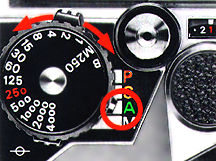 |
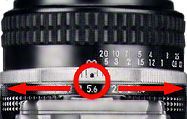 |
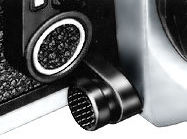 |
1. To setup the FA in this mode, first set the mode selector to A.
2. Set the lens to the desired f-number. Although each number on the lens aperture ring has a click stop, you can also set the ring to intermediate settings. Note that small apertures give greater depth of field, while large apertures restrict the zone of sharp focus to the main subject. The shutter speed dial can be set at any position except M250 and B.
3. Confirm that automatic multi-pattern metering is in operation by making sure that the metering control button is in the normal "out" position and the red index is not on top. You can also use the center weighted metering with exposure lock and exposure compensation dial for fine tuning exposure control.
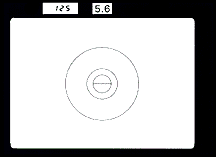 |
4. Look through the viewfinder and check the exposure information. The aperture you set will shown through the ADR window). When the shutter release button is depressed halfway, the LCD shows the shutter speed selected by the camera to obtain correct exposure with the aperture you set. If necessary, use a wider aperture to prevent a slow shutter speed from causing blurred images. |
Warning Indications
If the LCD shows 'HI', this means the scene is too bright and there is no shutter speed to match the aperture you selected. In this case, overexposure may occur. To prevent this, stop the lens down until 'HI' disappears, if all else fails, attach a polorizer (lowering 2 stops), a neutral density (ND) filter to the lens (Different grades) or change to a slower speed film as the last means.
![]()
If the LCD displays 'Lo', the scene is too dark and there is no shutter speed to
match the aperture you selected. In this case, underexposure may occur. To prevent
this, select a wider aperture or a faster speed lens or, if necessary, attach an
electronic flash as supplementary artificial light source. As a last resort, change
to a faster film.
![]()
In the aperture priority mode, only these two warning indication is provided. If
you have seen any other like the 'FEE' symbol appears in the LCD, most probably you
have set up your FA in a shutter priority or you are in programmed modes. Anyway,
as most earlier Nikon bodies are using aperture priority AE as their prime automation
method prior to the FG and the FA, an experienced Nikon user should not have any
problem handling this mode. The Nikon FA's 12L LSI controls shutter speed steplessly
from 8 sec.to 1/4000 sec. and shutter speed indicated on the dial (except the M250
and B) are available with pin point timing accuracy assured by a 32.8k hz quartz
oscillator. Nikon cameras have been featured in this site using the Aperture Priority
AE are F3, Nikkormat EL, EL2, FE, FE2. You may cross check with these site for comparison.
M Mode (Manual
Exposure Control) In the
manual mode, you set both the shutter speed and aperture manually according to the
desired effect or in situation where you intend to lock in a certain reading for
sequential shooting. Necessary key exposure information is shown in the viewfinder.
With this mode, it's possible to create intentional over- or underexposed photos.
It's also good under specific shooting situations. Time exposures at the B setting
or mechanical release at M250 are performed in the manual mode. Flash photography
with flash units other
than Nikon dedicated flash
units should also be recommended to perform in this mode This mode, when works independently,
is just like operating a Nikon manual FM/FM2(n). Except that it is more precise in
its shutter speed, because in the manual mode, all speeds are quartz controlled while
the FM series bodies are timed mechanically. Setting up the camera to handle manual
exposure in the FA is equally easy.
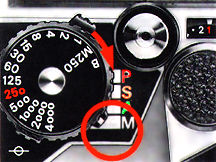 |
 |
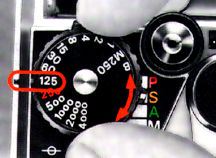 |
1. Set the mode selector to M.
2. Set the lens to the desired f-number. Although each number on the lens aperture ring has a click stop, you can also set the ring to intermediate settings.
3. Set the shutter speed dial to the desired shutter speed. The numbers on the dial are reciprocals e.g., 4000 means 1/4000 sec etc. The 250 engraved in red indicates the fastest sync speed for an electronic flash unit. Although the mode is called 'manual', but each setting has a click stop and shutter speeds from 1 to 1/4000sec. are electro-magnetically (Quartz actually) controlled while the FA's shutter is mechanically controlled at M250 and B.
Note: The shutter speed dial should not be set between click stops when you are in manual mode. Fine adjustment of the exposure should be performed by adjusting the aperture ring instead. In the M mode, regardless of where the metering control button is set, the meter uses only the center-weighted metering pattern. In the M mode, there are no warnings given other than the -/+ indications.
The viewfinder changes accordingly
when you are in the manual exposure control mode. Since it is a direct relation between
aperture and shutter speed, both information are displayed. Other secondary info
in the viewfinder are the flash ready light when you have mounted an dedicated flash
unit on.
 |
Center your main subject in the viewfinder and check the exposure information. Remember that in the manual mode, Centre-Weighted metering is always in operation regardless of the position of the metering control button. The selected f-number is shown through the ADR window. When the shutter release button is depressed halfway, the LCD shows the selected shutter speed preceded by the letter M. |
If the -+ indication is displayed above the M, you will get the correct exposure with the selected combination of aperture and shutter speed. If only - is shown, this indicates possible underexposure: use a wider aperture or a slower shutter speed. If only + is shown, this indicates possible overexposure: in this case, use a smaller aperture or faster shutter speed. If the symbols -+ blinks occasionally, this indicates a theoretical correct exposure is within +- 1/3 stop. Exposure fine tuning can be done either by adjusting the apertures or if you wish, you can use the film speed dial and adjust the ASA/ISO film speed value to obtain a more precise reading or adjustment. (Warning: Remember to readjust the dial back to neutral or the right film speed setting after use).
| Back | to Main Index Page of Nikon FA
Other Technical
Issues
Relating to Nikon FA
Camera Instruction
Manual - HTML | PDF
(1.4 MB)
Main Reference
Map for Body -
HTML | PDF
(731k)
Specifications - HTML
| PDF (245k)
The AI-S Nikkors (related info | TTL OTF Flash Metering | Interchangeable Focusing Screens. The MD-15/MD12/MD11 Motor Drives | 3rd party Power Winder (new) | Flash Units - | SB-15 | SB-10 | SB-16B & Other Options | Databacks | Titanium Shutter | Variation : Mr Y K Wong from Singapore contributing 11 images of his Nikon FA GOLD
| Nikon FM series |
Nikon FE series |
Nikon
FA |
W A R N I N G: The New G-SERIES Nikkor lenses have no aperture ring on the lens, they CANNOT ADJUST APERTURES with any of these manual focus Nikon FE series SLR camera models; please ignore some portion of the content contained herein this site where it relates.
| Message Board | for your favourite Nikon FA camera
| Message Board | for your Nikon Optics in a shared environment
| Message Board | Specifically for Dispose or Looking for Nikon / Nikkor Photographic Equipment
Shared Resources: MD-11 | MD-12 | 3rd Party Power Winder Only for FM2(n)/FE2/FA | Focusing Screens | Titanium Shutter | Flash Units - | SB-15 | SB-10 | SB-16B & Other Options | Databack | Nikkor lens mount (related info)
Others:- Nikon AF-TTL Speedlights | SB-20 (1986) | SB-22 (1987) | SB-23 | SB-24 (1988) | SB-25 (1991/2) | SB-26 (1994) | SB-27(1997) | SB-28 (1997) | Nikon SB-29(s) (2000) | Nikon SB-30 (2003) | Nikon SB-600 (2004) | Nikon SB-800 (2003) Nikon AF-TTL Speedlight DX-Series: Nikon SB-28DX (1999) | SB-50DX (2001) | SB-80DX (2002)
Nikon
BC-flash Series |
Original
Nikon Speedlight
SB-2
| SB-3 | SB-4
| SB-5
| SB-6 | SB-7E
| SB-8E
| SB-9 | SB-E
| SB-10
SB-11
| SB-12 | SB-14 | SB-140 UV-IR| SB-15 | SB16A | SB-17 | SB-18, SB-19 | SB-21A (SB-29) Macro flash | Flash Accesories | SF-1
Pilot Lamp
| Nikon F | Nikon F2 | Nikon F3 | Nikon F4 | Nikon F5 | Nikon F6 | Nikkormat / Nikomat | Nikon FM | Nikon FE/ FA | Nikon EM/FG/FG20 | Nikon Digital SLRs | Nikon - Other models |
Nikon Auto Focus Nikkor lenses:- Main
Index Page
Nikon Manual Focus Nikkor lenses:- Fisheye-Nikkor Lenses - Circular | Full Frame |
Ultrawides Lenses - 13mm15mm18mm20mm | Wideangle Lenses - 24mm28mm35mm | Standard Lenses - 45mm 50mm 58mm | Telephoto
Lenses - 85mm105mm135mm180mm & 200mm | Super-Telephoto Lenses - 300mm 400mm 500mm 600mm 800mm 1200mm |
 Index Page |
Special
Application lenses: Micro-Nikkor Lenses - 50mm~55mm -60mm 85mm -105mm 200mm Micro-Zoom 70-180mm Perspective Control (PC) - 28mm 35mm PC-Micro 85mm Dedicated Lenses for Nikon F3AF: AF 80mm f/2.8 | AF 200mm f/3.5 EDIF Depth of Field Control (DC): 105mm 135mm Medical Nikkor: 120mm 200mm Reflex-Nikkor Lenses - 500mm 1000mm 2000mm Others: Noct Nikkor | OP-Nikkor | UV Nikkor 55mm 105mm | Focusing Units | Bellows-Nikkor 105mm 135mm Nikon Series E Lenses: 28mm35mm50mm100mm135mm | E-Series Zoom lenses: 36~72mm75~150mm70~210mm |
MF Zoom-Nikkor Lenses: 25~50mm | 28~45mm | 28~50mm | 28~85mm | 35~70mm | 36~72mm E | 35~85mm | 35~105mm | 35~135mm | 35~200mm | 43~86mm | 50~135mm | 50~300mm | 70~210mm E | 75~150mm E | 80~200mm | 85~250mm | 100~300mm | 180~600mm | 200~400mm | 200~600mm | 360~1200mm | 1200~1700mm
Tele-Converters: TC-1 | TC-2 | TC-200 | TC-201 | TC-300 | TC-301 | TC-14 | TC-14A | TC-14B | TC-14C | TC-14E | TC-16 | TC-16A | TC-20E
Recommended links to understand more technical details
related to the Nikkor F-mount and production Serial Number:
http://rick_oleson.tripod.com/index-153.html by: my
friend, Rick Oleson
http://www.zi.ku.dk/personal/lhhansen/photo/fmount.htm by: Hansen,
Lars Holst
http://www.mir.com.my/rb/photography/hardwares/nikonfmount/lens2.htm
http://www.photosynthesis.co.nz/nikon/serialno.html
Recommended Reading Reference on Nikon cameras and Nikkor lenses
IF you like this site, help to make it better !
| Nikon F | Nikon F2 | Nikon F3 | Nikon F4 | Nikon F5 | Nikon F6 | Nikkormat / Nikomat | Nikon FM | Nikon FE/ FA | Nikon EM/FG/FG20 | Nikon Digital SLRs | Nikon - Other models |
|
Back | Main Index Page of Nikkor Resources
|
Back | Main Index Page of Pictorial
History of Nikon SLRs
| Message Board | for your Nikkor optics ("shared" because I do wish some of you to expose to other's perspective as well. Isn't it a sad sate to see photography has to be segmented into different camps from the use of various labels)
about this photographic web site
Home - Photography in Malaysia |
A contributing effort to Michael C Liu's Classic Nikon Site.
Credit: Chuck Hester for some of his beautiful images used in this site; Ted Wengelaar®, Holland for his continuous flow of input; Lars Holst Hansen, Danish 'Hawkeye' who shares the same passion; Mr Poon from Poon photo for their input; Ms Miss Rissa (Sales Manager) & members of the Technical Service dept. of Shriro Malaysia, local distributor of Nikon cameras in Malaysia & Singapore, in providing so many useful input to make this site possible. Special thanks to Mr MC Lau, who has helped with his images of the MF-12 databack. Michael Tan, Pertama Photo (603-2926505) for lending his original Titanium Shutter Display Unit. Dave Hoyt who has prepared the introductory page and offer some images of his FE2 in this site.. Hiura Shinsaku, Nikomat ML, Japan for his contribution on all the various images; A contributing site to a long lost friend on the Net. Note: Certain content and images appeared in this site were either scanned from official marketing leaflets, brochures published by Nikon and/or contribution from surfers who claimed originality of their own work to publish in this site based on educational merits. The creator of this site will not be responsible for any discrepancies that may arise from such possible dispute except rectifying them after verification."Nikon", "Nikkormat", "Nippon Kokagu KK" & "Nikkor" are registered tradename of Nikon Corporation Inc., Japan. Made witha PowerMac.